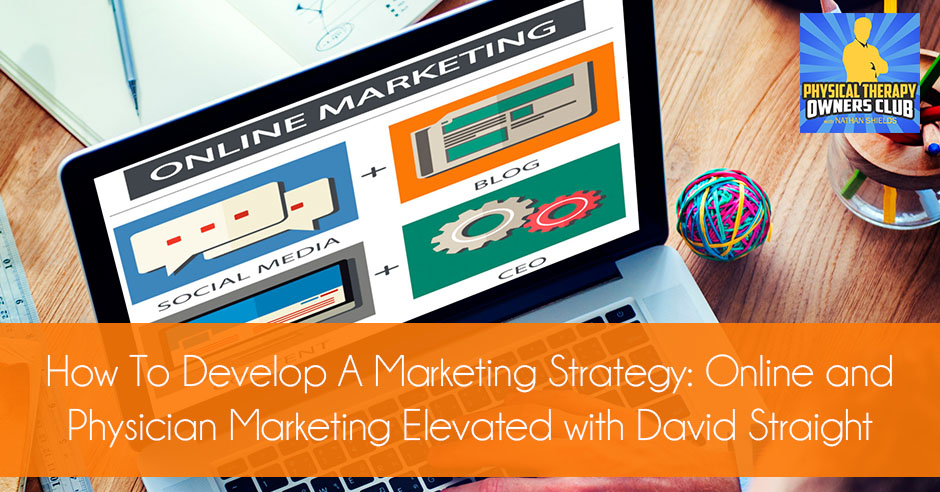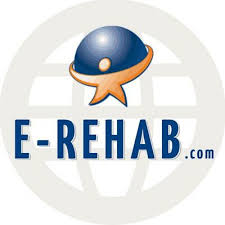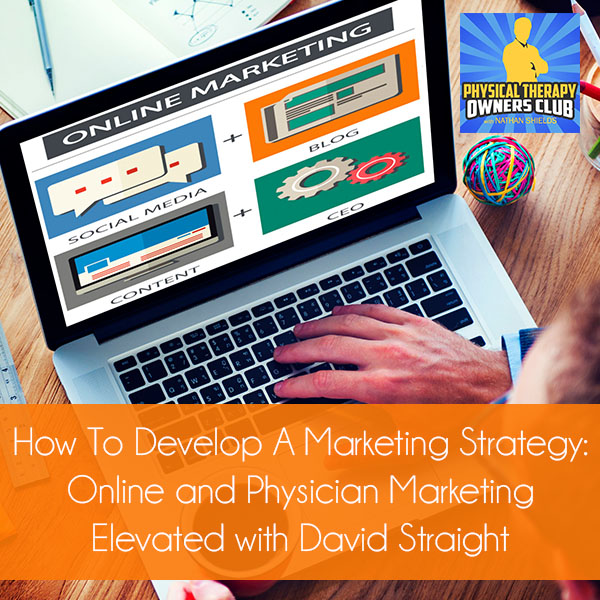
—
Listen to the podcast here:
How To Develop A Marketing Strategy: Online and Physician Marketing Elevated with David Straight
 This is a continuation of my interview with David Straight of E-Rehab.com. He’s the Co-Owner of E-rehab, which is a marketing company focused on digital marketing for physical therapy practices. If you want to know a little bit more about David Straight, his bio and E-Rehab.com and how it came to be and what they’re currently doing, you can check out part one of this episode. In part two, we go into developing your marketing strategy a little bit more for online, but also talk about the marketing strategies that you have for physician referrals. We can’t forget that, and it’s important to have that relationship with physicians in the community.
This is a continuation of my interview with David Straight of E-Rehab.com. He’s the Co-Owner of E-rehab, which is a marketing company focused on digital marketing for physical therapy practices. If you want to know a little bit more about David Straight, his bio and E-Rehab.com and how it came to be and what they’re currently doing, you can check out part one of this episode. In part two, we go into developing your marketing strategy a little bit more for online, but also talk about the marketing strategies that you have for physician referrals. We can’t forget that, and it’s important to have that relationship with physicians in the community.
We talk about essentially developing your marketing strategy both online and with physicians. I want you to focus on the exercise that he shares in the beginning, that he recommends is the foundation for your marketing strategies. He talks about some of the basics for what your website should look like and what your message should be. Pay attention to the first part of the interview as it pertains to digital marketing, he has a ton of good stuff to share. We’ll continue on with my interview with David Straight of E-Rehab.com.
—
I like what you were talking as we got started that it’s imperative that the PT owner finds out what they want and what’s the message that they want to convey. A lot of physical therapists have fallen into the trap of providing the same thing for everybody, just like every other physical therapy practice and that’s not finding a message that can resonate with people and set them apart. Is that something that you also work with your clients and helping them find their message and maybe what does set them apart and how they can specialize and not be so commoditized?
In fact, it’s even simpler than that. One of the best exercises that I would encourage people to do is take about twenty minutes of their time and ask five of their employees the following question. In 30 seconds, tell me what their physical therapy practice does, record that, and then transcribe that. You can use Temi.com, upload the recording from your smartphone and it will transcribe it all. You’ll find that in most cases, there are all kinds of ambiguity and it’s gray and people have a general, “We’re a physical therapy practice,” but there isn’t any consistent message. It’s a great place to build culture, to team build, to help people be clear about what you do and how you can help the community. Nowadays, there is so much noise and cutting through that noise in a world where most of it turned off through clarity can certainly take your business to the next step.
4 Key Aspects to a PT Website: Clean and clear tag line, Call to Action, Proof of Success, and Clear Categories of Services. Click To TweetSince there’s a lot of face-to-face communication, it’s a great way to help your team sell your practice for you. All you do is you extrapolate that with a little bit of messaging to the next level and you take the type of message and you put it on your website. Some things that I recommend that people have is to have a clear tagline about what you do and address both external and internal problems that people who are looking at your website might have. Take for example, an athlete has a knee problem. That’s his external problem, he has a knee problem and maybe he sprained his MCL. His internal problem is that he’s missing football with his buddies and he’s not able to contribute to the team.
Another example might be a mom who has severe neck pain. Her problem is she can’t move and she can’t turn her head, but the real internal problem is that she isn’t able to care for her kids. She doesn’t have time for all of this stuff because all these responsibilities piled up. The last example going through another market segment and so you would message them differently would be a 60-year-old guy that has an arthritic hip and likes to play golf. All this external problem is that it hurts when he swings a golf club because of his arthritis, but the internal problem is that he’s not hanging out with his buddies on the weekend and that fulfills him in his life. Be clear about your tagline, who you help and how you help with their external and internal problems.
The second thing is to have a clear call to action on your website. I can’t tell you how many websites I’ve seen that don’t have their phone number at the top right. That’s the standard. Since not everybody wants to call right away and some people are more digitally oriented, have an appointment request up there at the top. Repeat that in the middle of the page and at the bottom. That’s another thing that you can do. The third thing that I would suggest is to show proof of success. There are multiple ways you want to do this. First is use what we call outcome-oriented imagery. Think about those three groups or going back to your business plan and your marketing plan defining who you want to be. Think about those different audiences and think about the positive outcomes. Maybe a woman, if you’re doing women’s health, you have a happy smile with her husband next to her. Maybe if you do sports stuff, think about an athlete that’s excelling. Those are the pictures you have.
That’s one thing and the ratings and reviews and patient video testimonials. They are super simple to get nowadays. That segues into showing the proof that you’ve had success with people. The other thing is breaking down services into clear categories that you offer instead of just being physical therapy. We have these tremendous specialties now. Do you think it’s bad that nobody goes to physical therapy for musculoskeletal? Nobody’s going to therapy for things like vestibular and women’s health, they’re not even on the radar.
Have clear categories and then optimization for the mobile experience. You think that would be second nature, but I still see a lot that has very poor mobile experience. The other thing is to make online part of your educational process. Your website and the things you do online are not just for generating new business, they’re for transactional as well. You can have patients fill out their forms on your website, you can have appointment requests, and you can educate people about how you’re going to help them on your website. Transactional and educational things can be accomplished there as well. Those are the things that people should definitely implement in the design and development of their website.

I love that because it’s pretty simple. Make sure you have the tagline, your call to action, proof of success, and clear categories and services. Those things are basics and I’m sure you could look at many physical therapy websites and not see those things clearly laid out. If you’re considering the patient experience, your website has got to be high up on your priorities for making sure that’s a positive patient experience. Ease of access to communicate with you is right up there. You want to make that transition to you as smooth as possible.
Google says that patients want an easy and frictionless experience when dealing with healthcare providers online. Psychologically, we tend to think of things in threes and fives. What are the three steps to get started? They could be different things for different people. It might be, give us a call, schedule an appointment, start feeling better. Step one, step two, step three. Give us a call, come in for an initial evaluation, start your treatment program. You can define those. If you literally say, “With three little icons or three cards, step one, step two, step three,” these are the three things you should do right now, with a clear call for action right after it that says this is how you engage with our business.
There is so much garbage in marketing and people try to get fancy. They try to come up with weird things and we’re like, “What is that? What are you trying to say to these people?” They don’t want to do anything on your website, they want to feel better. That’s all there is to it. Making it simple in a world where we scan websites to demonstrate to them this is how you engage with our business and you can get started, that’s another thing I highly recommend to people.
If you look at some websites, it’s more about, “This is who we are.” You want to present that out there, but the call to action should be readily available. We look to these services in it and if you want any of these services or you’re interested in what we can provide for you, this is how you can get in touch with us. It’s got to be front and center.
What we like to say is that the patients that come to your website are the heroes, the therapist is the guide to get you back to where you want to be. If you’re very inner-directed in your messaging, “This is our mission. This is what we do,” there’s a place for those things, but it’s turning that focus outwards on the true heroes, which are the patients that want to get back to their life. It’s so critical, and this is something that people screw up all the time. What they do is they confuse physical therapy and they think that people want physical therapy. No one ever wants to call an emergency plumber. If I have a need though, then I want my need fulfilled now and then I never want to see you again.
Keep that in mind with your messaging and then the different promotional vehicles you use. You can’t induce demand for physical therapy. You can induce demand for fitness. You can induce demand for supplements. You can induce demand for massage. All of those things are hedonistic or people want those. They make you feel good. Physical therapy is a utilitarian service and it’s for good to help them get out of pain and to recover function. Keep that in mind with your messaging and the vehicles you use. That’s why you find the social media, for all it’s good, shouldn’t be your top priority, unless you spend a lot of money. This goes back to your market, how they behave, the message that you create, and the medium you use to deliver that. It all comes full circle when you think about it in detail and you have a good plan.
The patients that come to your website are the true heroes. The therapist is just the guide to get you back to where you want to be. Click To TweetI appreciate you taking the time to share so much of your insights, Dave. It’s been great. More physical therapists need to recognize how important it is to put together ideas. Recognize where they are in their stage of business and put an effort behind. Budget out for their online marketing presence and push that forward so they can stay on top of what’s going on in the trends that are happening. Did you say you wrote a book? Is that something that you want to share with us?
I wrote a book and I’m in the process of revising and writing the second edition. It’s called Book your Practice Solid: How to Use the Internet to Generate More Business for your Practice. We’re talking a lot about online marketing, but I hope I have impressed upon people the importance of having a bigger strategy, a marketing plan. Finally, depending upon your market, one of the best opportunities to generate business and for over 100 years, the pathway to getting into physical therapy has been through a referral from a physician. That study was from 2009 to 2013.
While referrals have declined, I would argue that it’s because people are busier, there’s more regulation, there’s more documentation. Traditionally, people fall back to habits that they were taught. The reality is that more people are dying of opioid addictions than ever and that no one knows about physical therapy. While for example, your general practitioners and your internists have the highest level of trust, this is in consumer reports, they have the lowest satisfaction when it comes to the management of back pain. That can be extrapolated to the management of any musculoskeletal problem. While we hate the idea of going to a doctor and then the front office person says a doctor doesn’t have the time or they don’t refer to physical therapy, we already have our source.
We do that, go to one doctor and we’ve heard this negativity in our profession. We extrapolate that to all doctors. When it comes to marketing, marketing is always about numbers. While I may go to twenty doctors and ten of them tell me to take a hike and don’t come back, five of them might be interested and five more will say, “I need help with my patients and I know it but I don’t have a lot of time.” If you speak to physicians in their language, clinical research and you don’t necessarily make it the goal to talk to the doctor, but to build the relationship with the entire office, you have solutions already prepared. In fact, you know better than they do because you have more education about your practice.
You can develop some tremendous relationships and help the doctor out where they wouldn’t have known about it before and they haven’t learned it in medical school. Your orthopod thinks physical therapy is a protocol and your GPs and internist maybe optionally got a class where they were taught about how to evaluate musculoskeletal from a PT, ten or twenty years ago. As a result, they write a prescription for what used to be your Cox-2 Inhibitors. Those killed a lot of people’s hearts so then they flipped over to opioids. Now we’ve got a bunch of addicts. I would encourage people to understand who they’re selling to. This is selling, belly-to-belly, we defined it selling. That’s face-to-face. It’s about understanding that there’s still an opportunity there to go out to the doctors, and your GPs and your internist are the best.

As Tim Flynn says it so well, “We want to keep people out of the medical industrial complex where they get over-medicalized and over-diagnostically tested and over-treated when they could have gone to us first.” We don’t want to demonize the doctors, we want to reach out to them as well. That’s where a lot of people don’t. There’s this understanding that we want to have consumers directly to us. At the same time, for many, if part of their marketing plans is to actually perfect the sales process with physicians, it can transform your business dramatically.
That’s huge because the patient’s going to get to the general practitioner if they’re having some issue. They’re not going to spend all their time online and they don’t necessarily know about physical therapy and what it can do and provide. You have to maintain that relationship with the physician and it’s a sales process and let them know that we are the experts in rehabilitating musculoskeletal issues. When a patient comes through for back pain, they need to come and see us as soon as possible. We get the best results if they come sooner rather than later.
You made a key point there. You said something in passing that was key though, we need to show them. What most salespeople do and physical therapists usually do is they go into the office, if they’re lucky, they get past the gatekeeper and they might be taken to somebody else, but they only go once. Secondly though is they give brochures and referral pads. They don’t speak to or are willing to show the doctor what their solutions are in a language that they understand. That’s not your brochure. It’s clinical research.
When a pharma rep comes in and they come in several times a day, they’re using case studies and random controlled trials and things of that nature to get the doctor to question whether or not this is something that might be appropriate for their patients. You do that and what we recommend is to couple that with social proof. Survey your doctors in the community. Survey all of the doctors and ask them questions that are all naturally going to point to you being the solution. Use peer pressure, so to speak.
Turn your focus outwards to the true heroes, the patients who want to get back to their life. Click To TweetAll of the doctors think they know about physical therapy and all the doctors think it’s appropriate to refer my patients to one alternative. Doctors down the street are saying this. You should have this thought process to that your patients want solutions, they don’t want drugs, they want alternatives. We’re hearing that and the evidence supports that. Not by brochure, that’s being another commoditized type of sale. Prove to them that it’s better than the other things they’re doing. Finally and most importantly, do that repetitively, the same message over and over again. When you see you’re getting through or you’re not, you can switch your message but through repetition, that sales process, you can sell.
We know better or I would argue about best of all, what to do conservatively for musculoskeletal problems. Keep dripping that message on them over the course of several months and then when you have some influence with them, then you can switch to the next message. The only way that happens is if you go out, you work out, you get outside of your office and you sell. Scale that to someone else who does it for you. I thank you for allowing me to share that because that’s what’s made a huge difference in our practice. It also helped several others when they explored that part of their marketing plan that’s generating more physician referrals, in conjunction with also looking at going to the community and generating repeat business too.
I love that you shared that because we have to recognize that a lot of people, not just physical therapists, shy away from the term sales. No physical therapist wants to be seen as a salesman, but you’ve got to recognize that. I love how you brought up that the reason why the pharmaceutical reps go into the offices and share case studies and talk the terminology is that they’re talking at the physician’s level. Rarely have I seen where we go in and have that same level of conversation, where we’re talking about case studies and what we provide that is been shown to alleviate back pain or have been successful and the results are this. I don’t think we do a lot of that kind of leads to the doctor.
We don’t. We’re almost physical pharmacists. We fulfill the orders and for those that actually have taken upon themselves to learn how to do this, they’re having conversations. The response is typically, “I had no idea you ever did that. I had no idea you knew that.” When the opportunity exists, where you can have those conversations and you bring to the table solutions to problems that others don’t even know, it puts you in a great place when you’re building that relationship. I highly recommend it if somebody wants to grow and that opportunities to learn how to sell. That’s training that we have for our clients that are interested. The reward is potentially tremendous. You can develop ten, twenty, 50, 100 more referrals literally. We’ve seen that per month, if you do it right. When that reward is potentially so high, there’s a lot of resistance or work to master that process. It’s not, “I’ll click the button to pay to run Google Ads.” That’s easy and everybody does it. This is something that it takes some time and effort and consistency but if you do, it can make a difference for you.
I can only imagine that the one way to set yourself apart in the physician’s eyes is to be the guy that knows what he’s talking about. Share some of this information and talk to them about studies and case studies and of physical therapy. One of the reasons why physician referrals have decreased so much in our current experiences is that they just hand the prescription to the patient and say, “Go find a place. Pick from a list,” and they’re going to look at your online presence. Can you see how effective that would be if you went to the doctor who has recently talked to you about what it takes to overcome lower back pain? They might say, “I have a lower back pain patient, I should send them to this physical therapy because these guys know what they’re talking about.”

We did things to facilitate that. We’d go in and spend a day with the doctor, find out what they were saying and identify opportunities where patients typically come in for example and say, “My back’s killing me.” You and I know that pain is not proportional to pathology. That being the case, we would help the doctors. The doctor would know very well that, “I shouldn’t order an MRI. They hurt their back four days ago.” The best thing to do is to get them to physical therapy or help them understand that because the pain is bad, that doesn’t mean you have a blown-out disc that’s going to cause whatever. We went in and we helped the doctor by saying, “What if we developed some educational collateral for you?”
They will give this to the patient and say, “If you get to a physical therapist that I’m going to refer to you, within two weeks, you’ve got a 50% less chance of having a surgery, 50% less chance of having injections, 40% less chance of imaging, 11% less chance of a prolonged use of medications.” It reinforces what the doctor didn’t know because they didn’t get this information. They may have thumbed through it, but they go back because they’re so darn busy. They don’t want to piss off their patient. They want the patient to come back to them. Why is it that we see drug commercials all the time? Because the doctor’s going to make a decision as to whether or not that’s appropriate for their diagnosis, but the patients drive a lot of the care. It’s proven. There’s certainly an opportunity to collaborate with doctors which are out of our comfort zone. That’s where that magic happens. I encourage people to make that part of their marketing plan but also implement the other things as well.
There is so much garbage in marketing and people try to get fancy. Click To TweetIt’s not all about the online stuff. We have to have a good online presence and have a budget set aside for that, but you can’t give up the relationships that you have with the physicians. That’s your bread and butter.
You have a mature and successful practice, but for somebody who’s just starting or somebody who’s struggling or somebody who wants to try to get to the next level, they have no knowledge of how to sell. They’ve heard nothing but negative about it. They may read this study where referrals are declining over time. Physical therapy and healthcare are hyper-local. Just because it happened somewhere else that way or just because you read a study with thousands of referrals or hundreds of thousands of referrals, it doesn’t mean that that’s necessarily what’s going to happen in your community. I would encourage people to explore the opportunity. It’s not just with physicians either, but reach out and find out how they can help other people and share what they do. That starts first with having confidence about what you do and why you’re justified to have that piece of the fire or why you should be treating that patient versus a personal trainer, a chiropractor, an acupuncturist or a medical doctor.
You need to understand that. That’s training that we help people with and a lot of people don’t know that. It comes from not tactics. I’ve seen so many people go through the cycle. It’s like, “I need more referrals, I need more money.” The natural thing would be to go market. They don’t, because they feel inadequate, so they go learn something. When they go learn something, they go, “Now I’ve got to execute it, but that’s what I don’t have time to do or I’m confident doing.” They go back and then they fall back to the cycle, “I need more money and I’m in fear and uncertainty and in doubt. I need to learn something instead of the market.”
They’re always looking for silver bullets and I can tell you that big businesses don’t become big businesses by firing silver bullets or throwing spaghetti at the wall. They have a marketing plan and a business plan. They use tactics like online marketing tactics to help them achieve their marketing and business goals. This way your podcast is so valuable for people and all the experts that you have on is so valuable for people. For me to say, “Just follow or just sign up with me and all of your woes will be over,” it’s not going to happen. If you want to be successful in this hyper-competitive environment that we’re in, the thing that gives me so much hope about the future is number one, value is going to continue to drive the healthcare market. We still have value-based networks.
Even though everybody’s selling and buying and collecting outcomes, it hasn’t been connected yet. That’s one thing. The other thing is the massive need for what we do and the under-utilization of our services and for those three reasons, even in the right markets, you can’t compete in some markets. Sometimes it’s impossible to penetrate but most of the nation, there’s still a great opportunity to be successful as a private practitioner.
No physical therapist wants to be seen as a salesman, but you've got to recognize that. Click To TweetI’m glad we’ve got to talk a little bit more about stuff related to not just the online presence. We can talk about some of the face to face, one-on-one relationships that need to be built in order to be successful. It’s not just salesmanship with a physician, but you’ve got to learn how to sell your services to the patient. Learning how to sell is something that’s imperative for us as healthcare providers.
If I may take all the stuff that we weave through and circle back to summarizing. First, it’s about understanding who you are and having that confidence and then defining the people that you want to treat, defining who your ideal target market is. The next thing is positioning or developing your message. That’s where we talked about positioning and having a clear concise message. It’s doing that online and offline as well so everybody in your office knows exactly what the message is. Once that’s online, using those different communications vehicles as different types of media to get that message out through the most common way people access information and that’s online.
Also, it’s understanding when they come in, how to sell that service. It’s going to the doctors and being able to communicate to them because that’s the traditional pathway that’s still people come through. At least 70% of the time in my study, 60% or 70% are still referrals first, the first time they come in. Following through with some things to see if people can come back or were they likely to refer, which are other topics for other times.
If people wanted to get in touch with you, David, how would they go about doing that?
They can email me at Dave@E-Rehab.com. They can go to our website at E-Rehab.com and request a free consultation on there if they like. We have multiple calls to action. They can give me a call at 760-585-9097. I love to talk about this stuff. Thank you for the opportunity to have this dialogue.
You had a ton to share. I appreciate it.
I’m happy to share my time with others because I still have that fire as you can tell about our profession as being the best first choice for naturally conservative care for musculoskeletal and others too.
Thank you for your time. I appreciate it.
Thank you, Nathan.
Important Links:
About David Straight

David Straight is a fellowship-trained doctor of physical therapy, has treated patients for over 15 years, as well as an author, speaker, marketing expert, marketing director of a 7 location private practice, and co-owner of E-rehab.com. David and his business partner own and operate a digital marketing agency that serves the physical therapy private practice market. He and his company provide custom websites, high-value email marketing, local SEO, reputation marketing (not just management), affordable video marketing and consistent social media marketing for over 1600 locations across North America. He’s the author of Booked Solid: The Fast, Easy, & Affordable Way to Use the Internet to Drive More Patients in the Door. He has presented multiple national, state, and local professional conferences as well. His passion is to help people understand that physical therapy is the best first choice for neuromusculoskeletal conditions.

[…] next book that we’ve referenced quite a bit in my previous interviews with David Straight, Sturdy McKee, Chuck Felder, I’ve mentioned it also in Will Humphreys interviews, is The […]